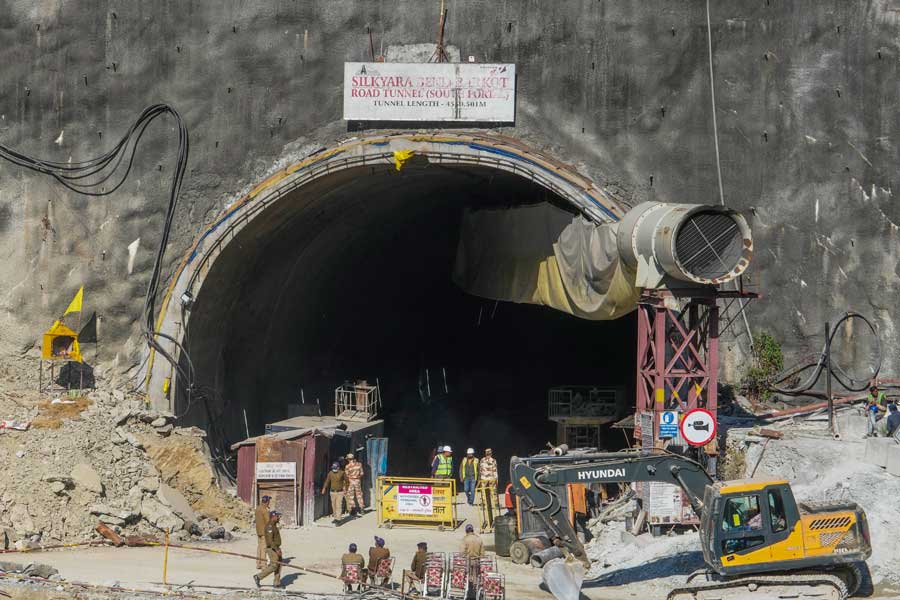The “hurdle” that held up the Uttarkashi tunnel rescue on Thursday was removed on Friday afternoon after it had severely damaged an auger machine, but the drilling that resumed in the evening stopped after an hour, apparently because of another “obstacle”.
Senior officials confessed to uncertainty about how many further obstacles to drilling might lie ahead and when they might be able to rescue the 41 labourers trapped in the under-construction mountain tunnel, by landslide-induced debris, since November 12. No one specified what the latest obstacle was — the third encountered since Wednesday night in a series of setbacks that have left the rescue effort stuck at 46.8 metres into the barrier of debris, still 10.2 metres short of reaching the labourers.
Earlier, the unspecified “hurdle” that had held up drilling on Thursday turned out to be steel pipes. When the rescuers tried to operate the auger drill with higher force to cut through the obstacle, the machine’s blades got damaged and its concrete base collapsed because of intense vibration.
Eventually, technicians of the New Delhi-based firm, Trenchless Engineering Private Limited, crawled through the 32-inch-wide Hume pipes bored into the mound of rubble and manually cut the steel with gas cutters, two senior officials said.
Trenchless staff had on Wednesday night used the same technique to cut through a steel girder that had halted the drilling for six hours.
On Friday, experts from US-headquartered technology firm Parsons Corporation arrived to try and predict, with the help of ground-penetrating radar, any further obstacles to drilling that lay in the rubble of the collapsed tunnel.
“Parsons Corporation told us there was no metallic obstacle in the next 5.4 metres (of the 10.2-metre-thick barrier of debris still remaining to be drilled through),” Neeraj Khairwal, an Uttarakhand government secretary who is the nodal officer coordinating with all the rescue agencies, said. He, however, cautioned that the Parsons study was “a tentative study and we don’t know about its accuracy because the place they studied is very narrow”.
“We have resumed horizontal drilling,” Mahmood Ahmed, managing director of National Highways and Infrastructure Development Corporation Limited, later said in the evening. “We hope we won’t meet any major obstruction, at least over the next 5.4 metres.”
The hope was short-lived.
Alternative plans
Syed Ata Hasnain, a member of the National Disaster Management Authority, told reporters in Delhi that the mobilisation of equipment needed for exploring “alternative options” had been speeded up.
He said these alternative options included the drilling of a vertical passage and two perpendicular passages (that is, across the width of the tunnel) as well as horizontal drilling from the opposite (Barkot) side of the tunnel.
Drilling from the Barkot side had been stopped when the drilling from the current side — Silkyara — initially raised hopes of success.
Some heavy machinery was seen being deployed late on Friday on the Barkot end to remove loose earth; this could be a prelude to plans to drill into the tunnel from that end.
“Equipment are on their way from Chhattisgarh, Madhya Pradesh, Uttar Pradesh, Gujarat, Rajasthan, Delhi and Haryana,” Hasnain said.
“District administrations across these states have created green corridors on the national highways to prevent any traffic-related delay. We have to speed up our work on the alternative plans if the ongoing exercise is elongated.”
The vertical and perpendicular drillings had been suggested several days ago and the sites had been identified. The Border Road Organisation built about 1,200 metres of road so that auger machines could be driven up to these spots. But the implementation was delayed when the horizontal drilling appeared to make headway.
However, comments by Arnold Dix, a freelance engineer from Australia who has been at the spot since Monday, appear to suggest that the alternative plans too contain an element of shooting in the dark.
Dix said he had suggested simultaneous vertical and perpendicular drillings but didn’t know which one would open up near the labourers.
The idea behind the horizontal drilling from the Silkyara side is to drive 10 Hume pipes welded together — each 6 metres long — into the 57-metre wall of debris to create a passage through which the labourers would be pulled out on wheeled stretchers attached to ropes.
Ahmed said that technicians had welded the ninth Hume pipe to the eighth in the night.
“We may reach the end of the debris within a few hours or it may take days in case we hit a hurdle. It’s better not to predict a timeline at this stage,” he added.










